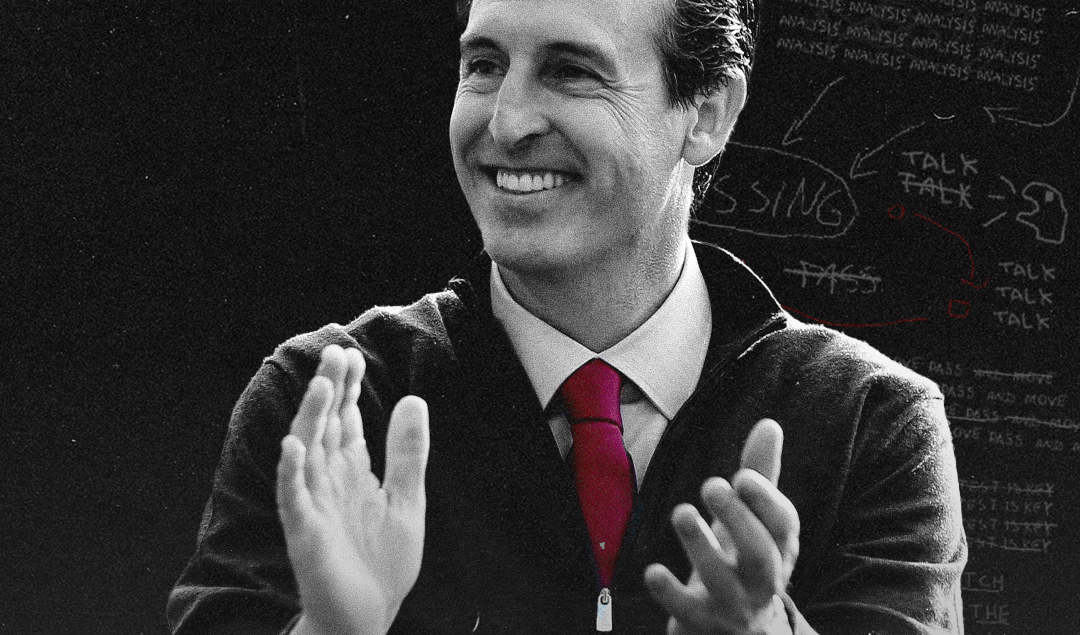Aston Villa’s Resurgence: The Unai Emery Effect
After a summer that saw them bring in the likes of Boubacar Kamara and Diego Carlos, things looked promising for Aston Villa. However, they would win just two of their first eleven league matches, grinding out narrow victories over Southampton and Everton, and their early-season struggles would see the club hierarchy make the decision to sack Steven Gerrard and hire Unai Emery.
Fast forward nine months, it’s safe to say this decision has paid off. Whilst Gerrard picked up just 13 wins in 40 matches, Emery has already registered 15 in 27. Villa excelled under the Spanish manager and surpassed expectations, beating the likes of Tottenham, Newcastle, Chelsea, Brighton and Manchester United along the way.
The final day of the 2022/23 Premier League campaign would see the two revelations of the season — Villa and Brighton — face off in the West Midlands. Whilst Roberto De Zerbi’s side had already assured themselves a place in the 2023/24 Europa League, Villa were in the driving seat for Europa Conference League football. The hosts opened the scoring within eight minutes as Douglas Luiz gave Villa an early lead.
If we take a closer look at this goal, we can see Emery’s defensive plan pay dividends. John McGinn positions himself near Alexis Mac Allister with the rest of the players closing down the middle and forcing Brighton to play wide. Adam Webster tried playing a difficult pass to Mac Allister, who ended up losing the ball and enabling Villa to start their counter. This shows how Emery values having multiple players inside the box to create discomfort for the opposing defense.
Ollie Watkins, John McGinn and Leon Bailey position themselves near the penalty spot whilst Luiz finds himself just outside the box, giving a different option to the ball carrier Jacob Ramsey. McGinn wins the ball and quickly launches the attack, with Ramsey finding Luiz for the opening goal.

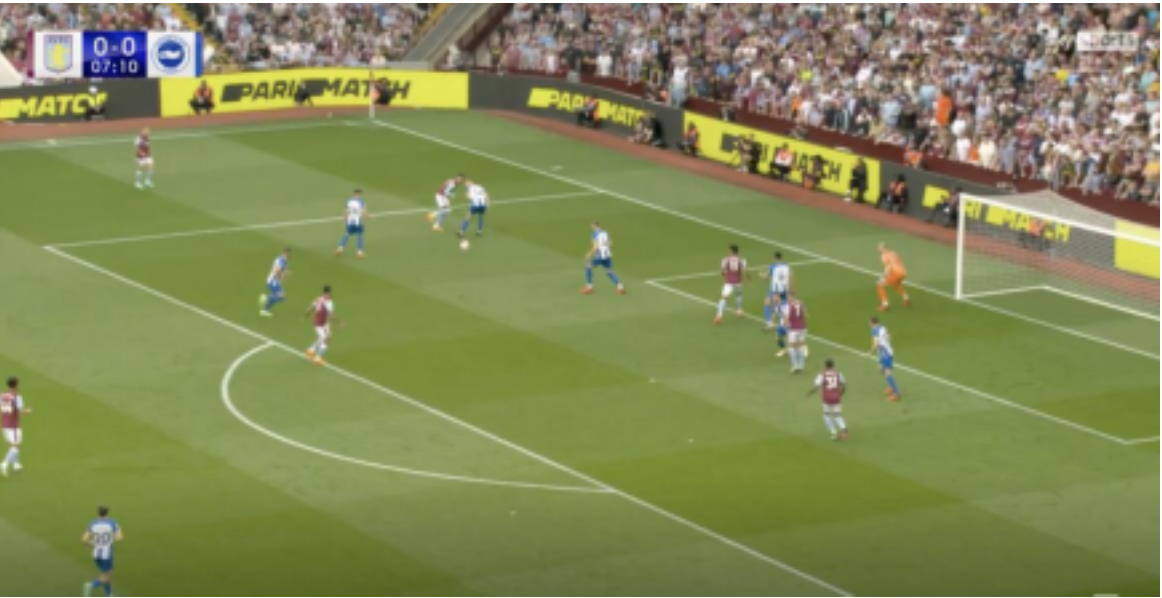
Brighton were utilizing a back three in the build-up composed of Levi Colwill, Webster, and the right back Joël Veltman, whilst Pascal Groß was playing as an inverted fullback. Brighton struggled to evade Villa’s pressure, with goalkeeper Jason Steele and their defenders constantly making mistakes in possession. Villa was pressing high up with McGinn essential to this strategy, constantly closing Mac Allister down and preventing him from linking up defense and attack. Villa’s aggressive pressure, led by Watkins, would eventually lead to Steele coughing up possession.
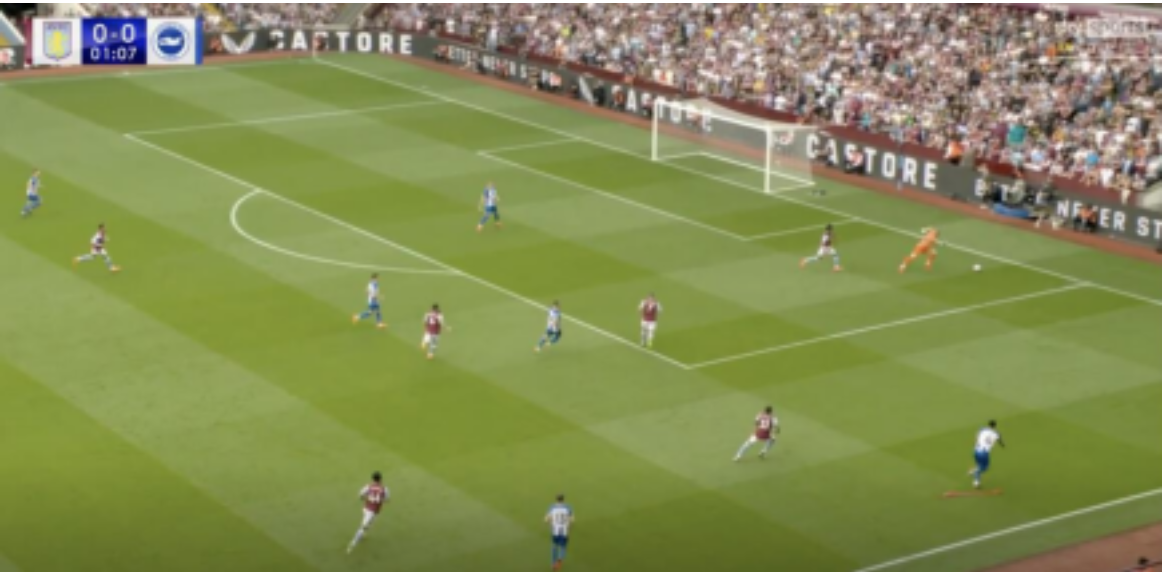
Villa operate with a two-man build-up, with the center backs Ezri Konsa and Tyrone Mings staying relatively wide, whilst the fullbacks Matty Cash and Lucas Digne stay wide and create free space in the middle for Boubacar Kamara and Luiz. Bailey and Ramsey stayed deep and wide whilst McGinn positioned himself near Watkins so that the Scottish midfielder could win the second ball after Watkins’ aerial duel with the Brighton defender.
In order to prevent the opposition from playing out from the back and manipulate their build-up play, Brighton tried to force Villa to build from the right, targeting their less technically proficient defenders in Ezri Konsa and Matty Cash, with Tyrone Mings and Lucas Digne on the other side. Mings is skilled at breaking the lines with his passing, completing 113 progressive passes last season, in comparison to Konsa’s 68.
Konsa often struggled with this pressure and would lose the ball in dangerous areas — taking into account these deficiencies, Villa signed Spanish center back Pau Torres from Villarreal for €36.7 million. The 26-year-old reunites with Unai Emery, having won the Europa League together just two years ago, and he will be looking to provide plenty of quality on the ball in terms of his passing and dribbling. He was one of the best ball-playing defenders in Spain, registering 197 progressive passes, the 10th-most in La Liga last season.
Villa have not only secured the signing of Torres, but they’ve also completed the arrival of Belgian midfielder Youri Tielemans on a free transfer. A player with ample Premier League experience with Leicester and Champions League experience with Monaco and Anderlecht, he is skilled at playing under pressure, boasting great vision and passing accuracy. Both signings should help make Villa’s build-up play far more effective.
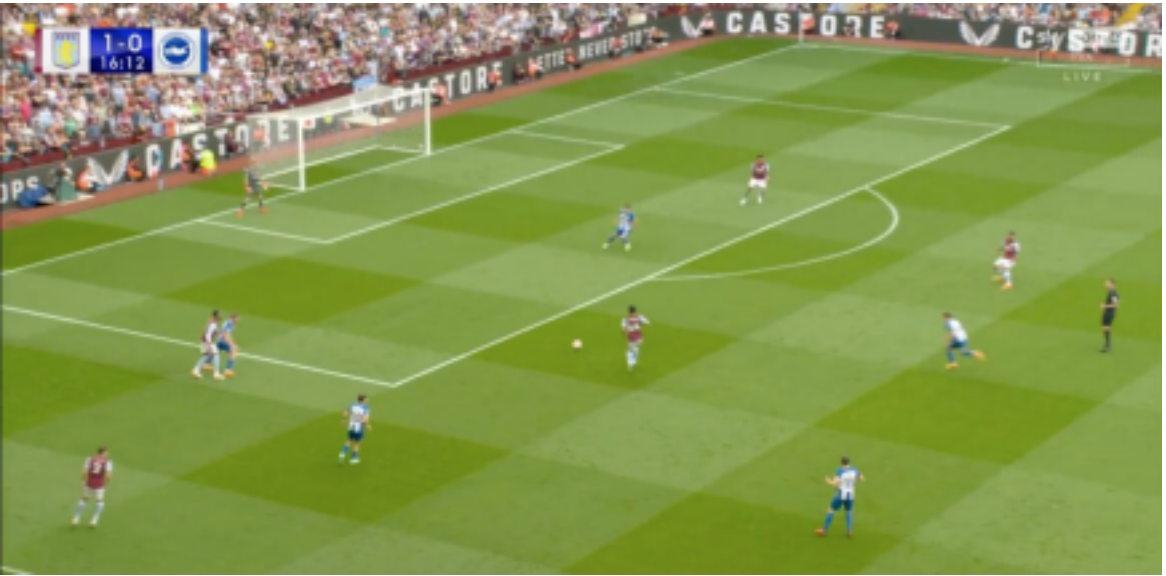
However, there were several occasions where Villa’s build-up play ran smoothly, such as this example where Kamara received the ball under pressure and found an unmarked Luiz. The Villans would double their lead in the 26th minute via Watkins, whilst Deniz Undav pulled one back before the break. Emery’s side held on for a 2-1 win and secured a seventh-place finish, finishing one point behind Brighton and one point above Tottenham, and qualifying for Europe for the first time in 13 years.
Three months prior to this victory, Villa faced off against Manchester City at the Etihad. City were reeling from a 1-0 defeat to Tottenham in the previous week and found themselves under scrutiny after being hit with 115 alleged breaches of the Premier League’s financial rules. It seemed like an ideal time to face off against Pep Guardiola’s side, but ultimately, the cream rose to the crop.
The likes of Kevin de Bruyne and Bernardo Silva displayed their world-class quality, with the Cityzens moving the ball from side to side and forcing Villa’s players to chase shadows throughout the match. City took the lead via a corner kick within four minutes, as Rodrigo Hernández headed home to break the deadlock early on.
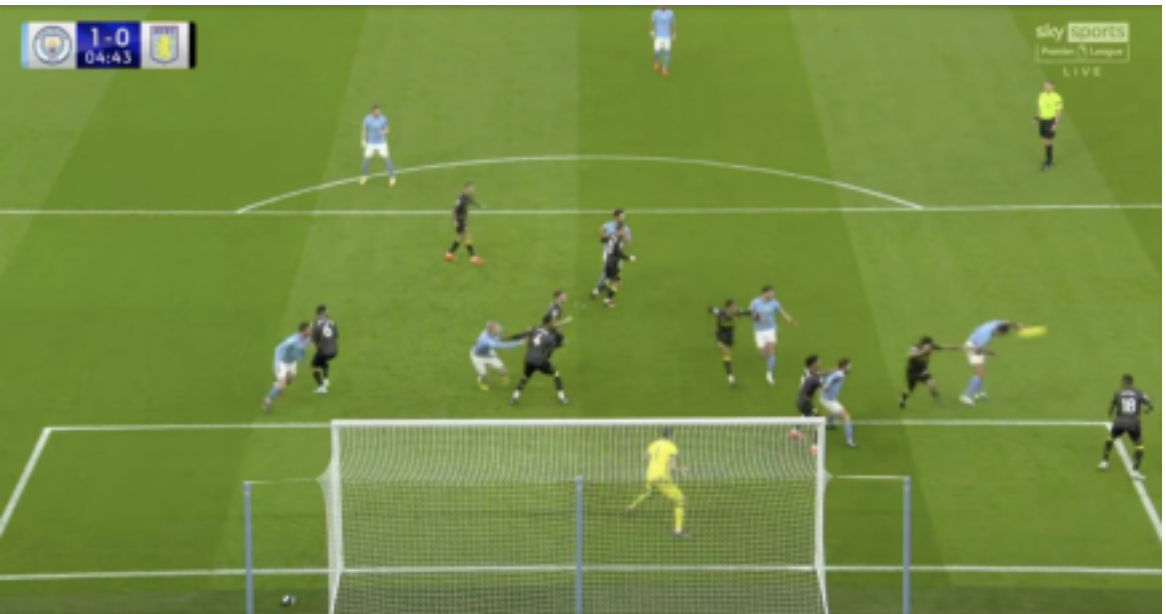
Whilst Rodri is excellent when it comes to aerial duels and attacking set-pieces, Kamara should have been more aggressive when marking him, whilst Ashley Young should have been positioned deeper in order to reduce the distance between him and Kamara.
With regards to the build-up, we saw a different approach to the Brighton match. Konsa and Calum Chambers stayed relatively wide whilst Young and Digne positioned themselves wide, but the main difference was in midfield. Against Brighton, Kamara and Luiz were positioned side by side, whilst against City, Kamara played as a lone defensive midfielder.
Emiliano Buendía, operating as a left-sided midfielder, would drop deep into the middle to create a triangle between Kamara and Luiz in order to provide more passing options to the center backs and also give Villa more players in central areas to win the second ball. However, Villa struggled to maneuever their way past City’s pressure, and the center backs or Emiliano Martínez would often be forced to go long to Watkins.
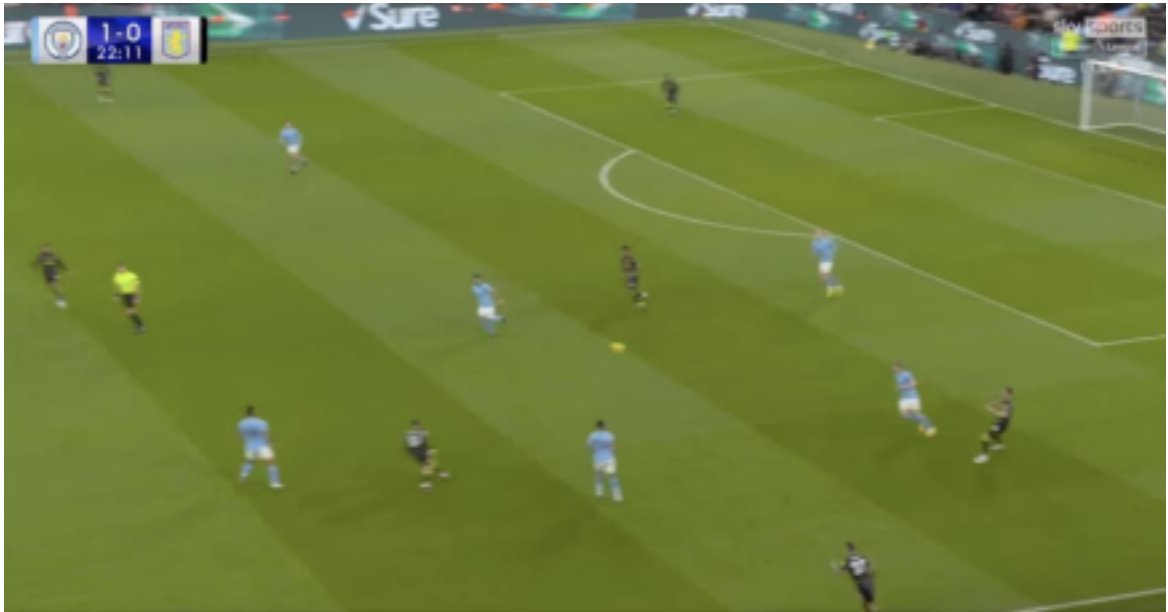
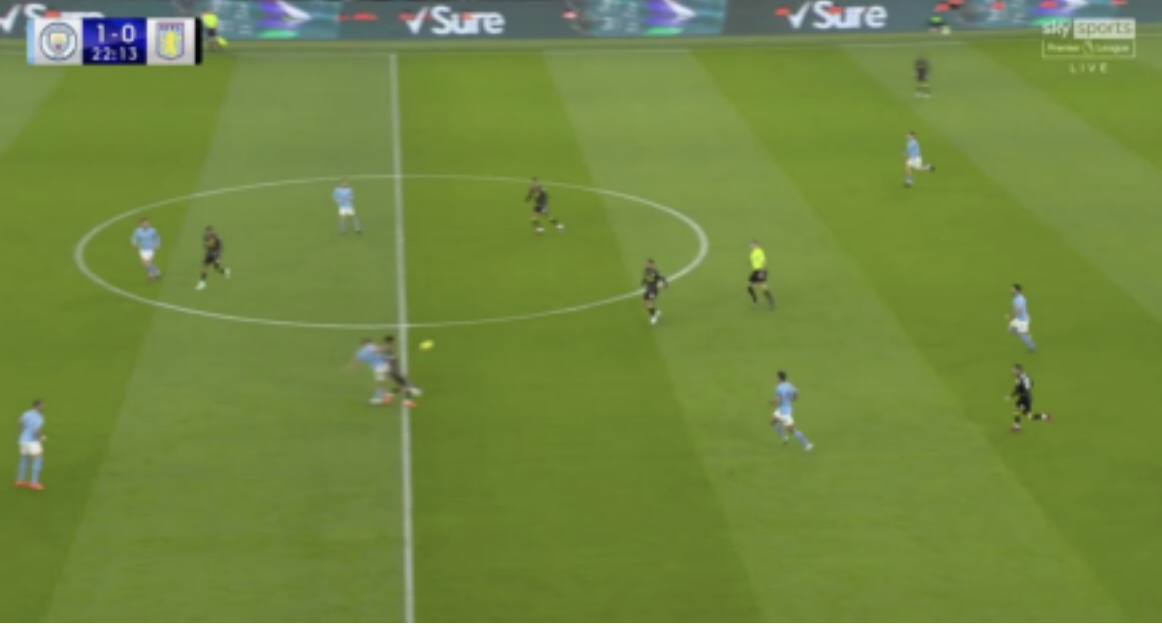
We can see a successful example of this vertical approach in the above example when Chambers plays a long ball to Watkins, who held off Rúben Dias and passed it to Luiz. However, they were unable to take advantage and İlkay Gündoğan doubled the lead shortly after whilst Riyad Mahrez tripled their lead from the penalty spot before the break. Villa did pull one back at the hour-mark, with Luiz recovering the ball high up the pitch and playing a superb pass to Watkins, who finished his chance brilliantly.
After an eye-catching start to the window that has seen Torres and Tielemans join and Young depart for Everton on a free transfer, Villa look set to make yet another blockbuster purchase with the signing of Moussa Diaby. The 24-year-old France international has emerged as a vital performer in attack for Xabi Alonso’s Bayer Leverkusen, racking up 14 goals and 10 assists in 49 games last season and averaging 1.7 successful dribbles per 90. Capable of playing on either flank and utilizing his speed and close control, Diaby is a deadly threat in transition — no player scored more counter-attacking goals in the Bundesliga last season than him.
Villa have reportedly reached a deal to sign him for €50 million, although Saudi club Al-Nassr are also pushing to convince him to reject their advances and link up with the likes of Cristiano Ronaldo and Marcelo Brozović. Signing Diaby would prove a major coup for Villa and a serious upgrade to their attacking options — above all, it would be yet another statement of their ambition under Emery.
Five years ago, Aston Villa found themselves on the brink of liquidation before Wes Edens and Nassef Sawiris took over. Today, they’re not only an established Premier League side, but they’re heading back to European competition after a 13-year exile. Under the guidance of Unai Emery, they have returned to the promised land.
By: Tomas Reis / @tomasmreis10
Featured Image: @GabFoligno / Barrington Coombs – PA Images
